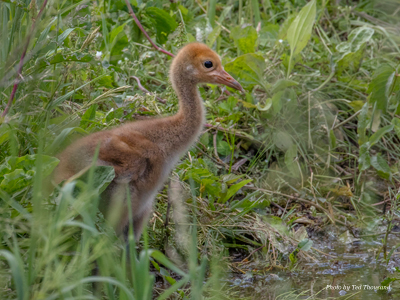Contact: Lizzie Condon, Keeping Whooping Cranes Safe Coordinator, 608-356-9462 x142
 Baraboo – Whooping Crane chicks have already started hatching at captive rearing centers across North America. This year, the captive-raised chicks to be released in Wisconsin will be doing things a little differently from their predecessors. The first thing Whooping Crane chicks will see when they hatch in captivity will be an adult Whooping Crane – not a human caretaker in a white crane costume. It’s the first step on a new path to bring a self-sustaining migratory population of Whooping Cranes to the eastern United States.
Baraboo – Whooping Crane chicks have already started hatching at captive rearing centers across North America. This year, the captive-raised chicks to be released in Wisconsin will be doing things a little differently from their predecessors. The first thing Whooping Crane chicks will see when they hatch in captivity will be an adult Whooping Crane – not a human caretaker in a white crane costume. It’s the first step on a new path to bring a self-sustaining migratory population of Whooping Cranes to the eastern United States.
The Whooping Crane Eastern Partnership’s 2016 cohort will learn behaviors from other cranes rather than costumed humans, and instead of following an ultralight aircraft, they will follow members of their own species as they migrate from Wisconsin to Florida.
Since 2001, the partnership has successfully taught young cranes their migration route from nesting grounds in Wisconsin to wintering areas in Florida using costumed humans and ultralight aircraft, as well as by releasing costume-reared birds directly into the wild flock. Those efforts have resulted in a population of about 100 Whooping Cranes in the eastern migratory population. Despite this success, the population is not self-sustaining due to poor survival of chicks hatched in the wild.
“These young cranes are doing just about everything we want them to do,” says Peter Fasbender, U.S. Fish and Wildlife Service field supervisor for Minnesota and Wisconsin. “They are migrating, establishing pairs, mating and laying eggs. The one thing they’re not doing is successfully raising their young.”
To address the lack of reproductive success, the U.S. Fish and Wildlife Service earlier this year recommended the partnership use more natural means of raising and releasing young Whooping Cranes. It is hoped that methods that minimize exposure to humans and provide more opportunities for chicks to interact with other Whooping Cranes will help the birds gain skills to successfully raise their own young.
This year, partners will use the parent-rearing method to release chicks hatched in captivity into the wild. In this approach, Whooping Crane chicks are raised in captivity by adult Whooping Cranes, isolated from human contact. In the fall, the young chicks will be released with wild Whooping Crane pairs or single adults, who will serve as surrogate parents, guiding the young birds on their first migration south.
“While our methods are changing, our goal remains to create a wild and self-sustaining population of migratory Whooping Cranes east of the Mississippi River. We are confident that by working together, using the best science, and adapting as needed, we can achieve that goal,” says Lizzie Condon of the International Crane Foundation.
The Whooping Crane Eastern Partnership is a group of agencies, non-profit organizations, and individuals formed to restore a migratory population of Whooping Cranes to eastern North America.
